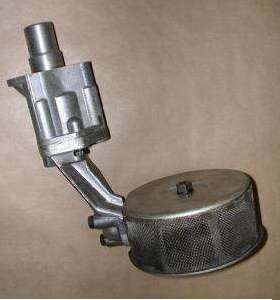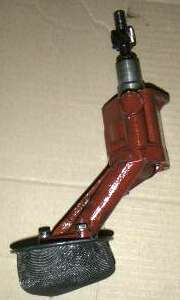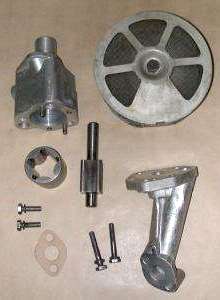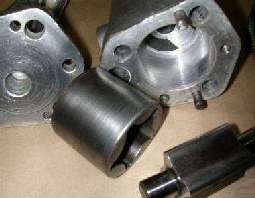The MGA With An Attitude
OIL PUMP CHANGES - OF-107A
This message may save your engine, especially if you happen to be a vigorous driver, periodically visiting the red line on the tachometer. There was a change in design of the MGA oil pump at engine number 46342 (also earlier engines 46045 to 46100) in September 1958. This was, incidentally, five months after introduction of the Twin Cam model, which happens to have a 7000 RPM redline on the tachometer.

Early style oil pump
1G2390 Strainer - oil [early 1500]
Fin (E)GB46044 except 46101 to 46341
|

Later style oil pump
1H1192 Strainer - oil [later 1500]
Com (E)GB46045 to 46100
then 46342 on, and all Twin Cam
|
12H984 Strainer - oil [later 1600]
12H398 Strainer - oil [1622]
1H1192 not available; use 12H984
I do not know the difference between these three parts. Possibly the first has roughly cylindrical screen as shown above right, while the others have more spherical screen.
|
Whenever possible, discontinue use of the 1G2390 early 1500 strainer and the early style pump. That is the flat/cylindrical strainer. You are not likely to find this type strainer new anywhere in the world, as its use was discontinued in late 1957, superseded by the later parts as matching set oil pump and strainer.
There is a split line between the main body of the oil pump and the extension arm which carries the pick up screen. Parts of the pump above the split line were unchanged. All of the differences are in the pickup arm and screen assembly. The bottom ends are interchangeable on the basic upper oil pump. The most commonly quoted reason for the change is to position the screen and pickup tube closer to the center of the sump where it would be less likely to suck air in case of low oil level and a fast turn. But there are more significant differences.

 The early screen is attached to the arm with a side entry gasketed joint. Inside the screen assembly there is a metal tube with a 90 degree curve which terminates pointing straight down very near the bottom plate. In the arm there are two oil passage drill holes intersecting at a sharp angle near the bottom end. The oil passage holes are relatively small, about the size of your pinkie finger. Oil must enter the first tube past a small gap above the bottom plate, then pass through a 90 degree curve. Next it encounters a sharp 90 degree turn in the bottom end of the arm, then passes upward through another relatively small bore to reach the bottom of the pump body. From there the oil passes up through a drilling in the side of the pump to enter the intake port on top. The outlet port is also on top where oil passes into drillings in the engine block where it encounters the pressure relief valve on the way to the rest of the engine.
The early screen is attached to the arm with a side entry gasketed joint. Inside the screen assembly there is a metal tube with a 90 degree curve which terminates pointing straight down very near the bottom plate. In the arm there are two oil passage drill holes intersecting at a sharp angle near the bottom end. The oil passage holes are relatively small, about the size of your pinkie finger. Oil must enter the first tube past a small gap above the bottom plate, then pass through a 90 degree curve. Next it encounters a sharp 90 degree turn in the bottom end of the arm, then passes upward through another relatively small bore to reach the bottom of the pump body. From there the oil passes up through a drilling in the side of the pump to enter the intake port on top. The outlet port is also on top where oil passes into drillings in the engine block where it encounters the pressure relief valve on the way to the rest of the engine.
The resulting oil flow path is relatively restrictive, especially in the intake parts below the pump split line. The only pressure available to force oil through the pickup plumbing into the oil pump is atmospheric air pressure at 14.7 PSI (at or near sea level). The oil pump is positive displacement type and will move 1/2 fluid ounce of oil for each turn of the input shaft. That turns out to be as much as 54 quarts per minute at 7000 RPM engine speed, or nearly one quart per second.

 Unfortunately atmospheric air pressure is not quite enough pressure to force that much flow through the restrictive pickup plumbing, so the oil pump will cavitate at about 6500 to 7000 RPM engine speed (depending on oil viscosity). That means the pump draws a vacuum bubble inside, and the oil suddenly stops flowing through the pump rotors.
Unfortunately atmospheric air pressure is not quite enough pressure to force that much flow through the restrictive pickup plumbing, so the oil pump will cavitate at about 6500 to 7000 RPM engine speed (depending on oil viscosity). That means the pump draws a vacuum bubble inside, and the oil suddenly stops flowing through the pump rotors.
No oil output means no oil pressure or flow. The crankshaft bearings can suffer sudden catastrophic failure in a matter of seconds at high speed and full throttle. The connecting rod bearings melt first with the soft white metal flowing out the sides of the journal like hot candle wax. End result is sudden loss of power when you have metal on metal contact in the bearing journals with no oil, and a loud rattling noise from the conrods with suddenly found increased running clearance. If you are quick enough to get off the throttle and reduce engine speed, you might be able to pour a couple cans of STP into the oil and nurse it home at low speed with some mild knocking noises. Then you have to tear the bottom end apart to have the crankshaft reground and replace the bearings. If you're less lucky, it may stretch the big ends of the conrods out of round, or it may launch part of a broken connecting rod through the side of the engine block.
The changes in the oil pump design are primarily to reduce the restriction in the pickup assembly. The newer oil pump has the pickup arm extended downward at about 45 degree angle with a bowl shape screen. The gasketed joint is on top of the screen assembly. Inside the screen the pickup pipe continues at the same angle to terminate about 1/4 inch above the bottom of the sump. End result is an oil pickup passage which is one straight shot from entry point to the pump body, and also with larger bore size. This later design is good for about 7500 RPM engine speed without cavitation of the oil pump. For the serious racer types the special tuning manual shows additional modifications to further reduce the pickup restriction, making the pump good for even higher engine speed.
The old pump design is factory superseded by the newer design. This means that when you order a replacement oil pump you should expect to receive the newer style, and it is HIGHLY RECOMMENDED that you do indeed use the newer style parts. Do not make the mistake of attaching the old pickup assembly to your new oil pump to save the cost of a new screen assembly, as that may cost you dearly the first time you accidentally (or intentionally) over rev the engine. This is most important in our modern era where many people like to install a warm cam or other power upgrades in the interest of sport or competition driving.
There is an additional modification you can do to the oil pump to further reduce the tendency to cavitate at high engine speed. This is of special interest to anyone building a competition engine. See OF-201.
|



